Personal and Professional Development: Communication Analysis
VerifiedAdded on 2023/01/18
|11
|3226
|74
Essay
AI Summary
This essay delves into the critical personal quality of communication within the context of personal and professional development. It begins by defining communication and applying the Cognitive Dissonance Theory to illustrate its role in understanding messages and influencing decision-making. The essay evaluates communication as a strength, particularly for supervisors, highlighting its benefits in critical thinking, eliminating misinterpretations, clarifying goals, and accepting changes. It further explores attributes like career self-management, career resilience, self-efficacy, and the importance of completeness. The essay also addresses difficulties such as lack of feedback, device chaos, language barriers, information overload, and lack of attention. The essay offers a comprehensive analysis of communication's impact on professional success, its attributes, and challenges.
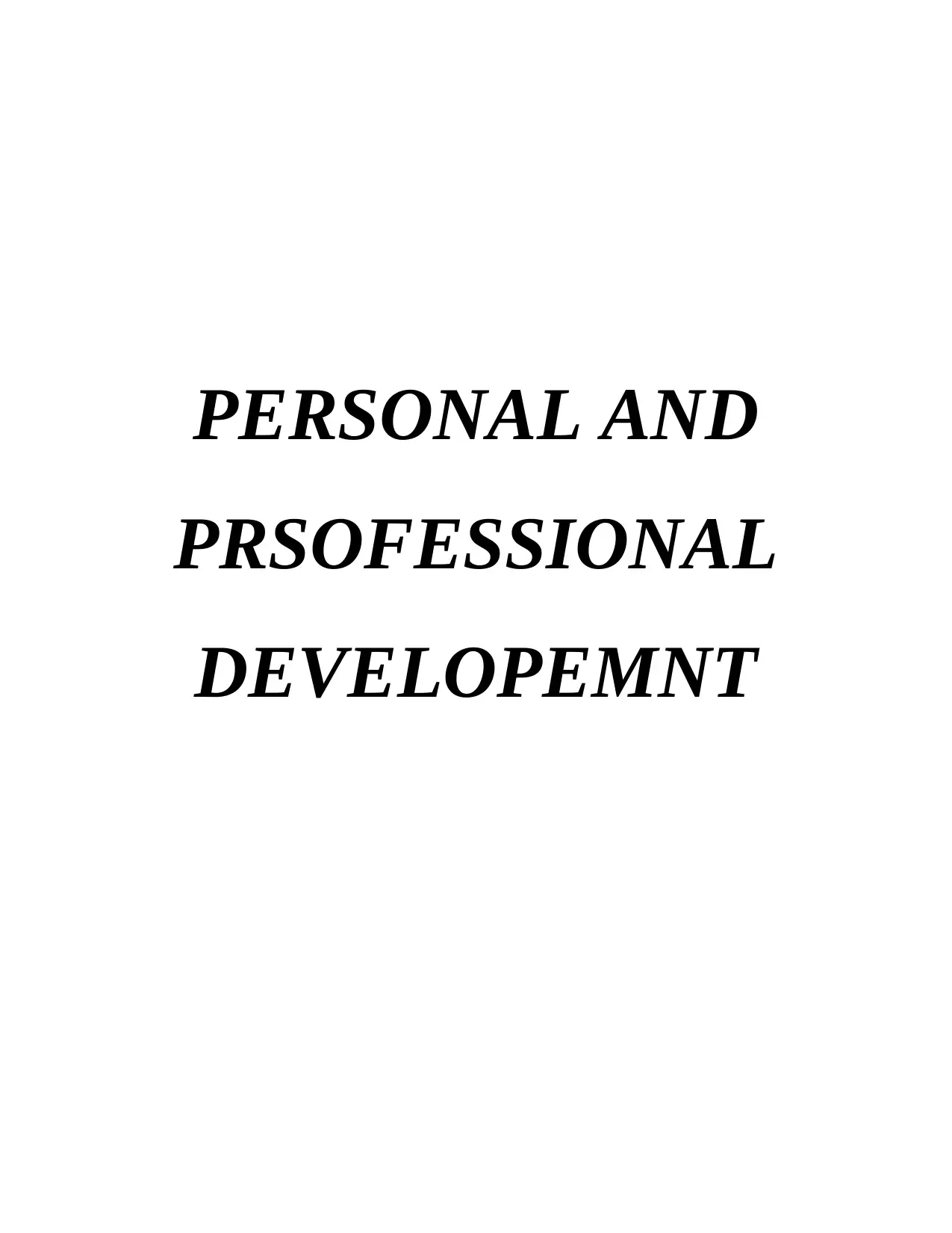
PERSONAL AND
PRSOFESSIONAL
DEVELOPEMNT
PRSOFESSIONAL
DEVELOPEMNT
Paraphrase This Document
Need a fresh take? Get an instant paraphrase of this document with our AI Paraphraser
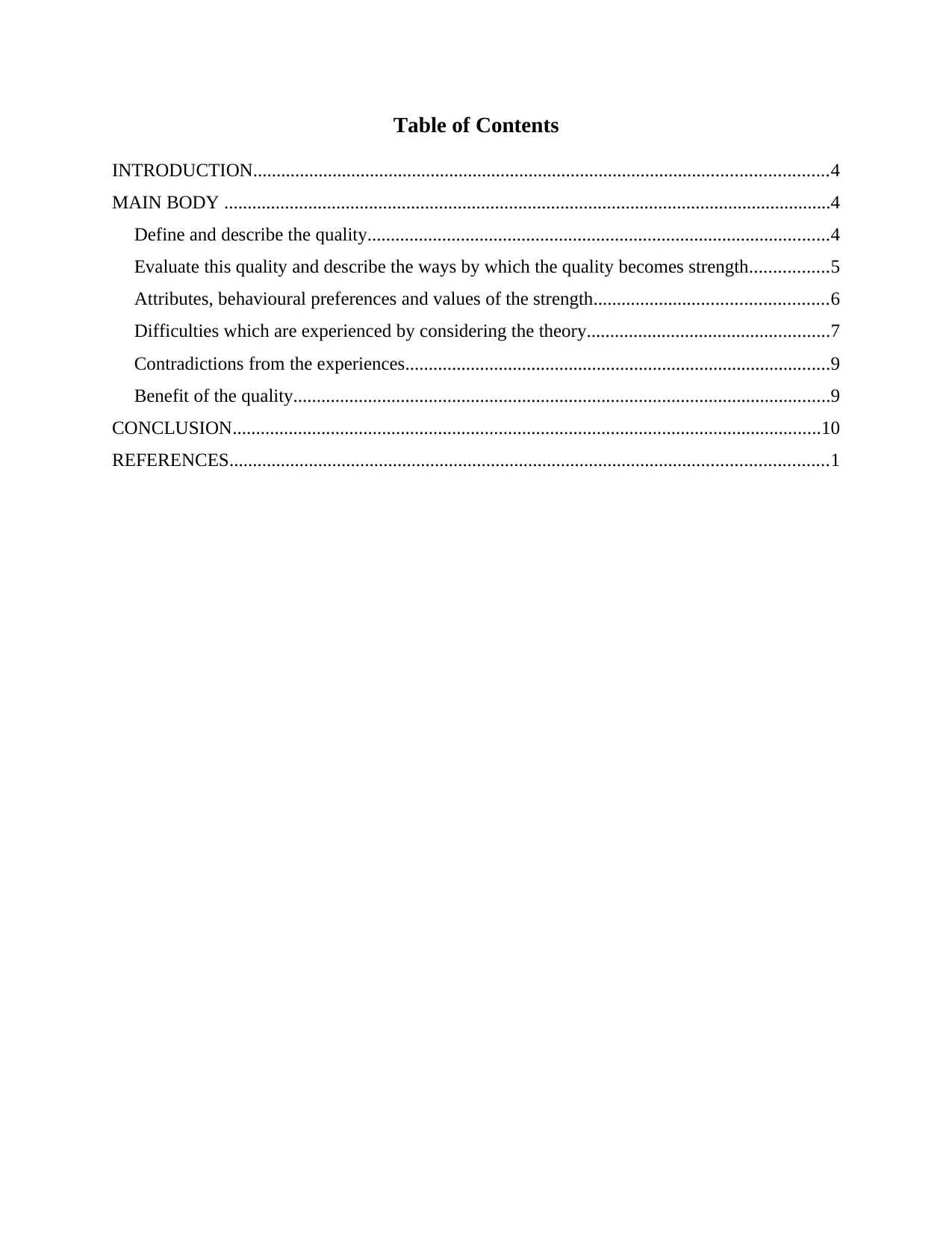
Table of Contents
INTRODUCTION...........................................................................................................................4
MAIN BODY ..................................................................................................................................4
Define and describe the quality...................................................................................................4
Evaluate this quality and describe the ways by which the quality becomes strength.................5
Attributes, behavioural preferences and values of the strength..................................................6
Difficulties which are experienced by considering the theory....................................................7
Contradictions from the experiences...........................................................................................9
Benefit of the quality...................................................................................................................9
CONCLUSION..............................................................................................................................10
REFERENCES................................................................................................................................1
INTRODUCTION...........................................................................................................................4
MAIN BODY ..................................................................................................................................4
Define and describe the quality...................................................................................................4
Evaluate this quality and describe the ways by which the quality becomes strength.................5
Attributes, behavioural preferences and values of the strength..................................................6
Difficulties which are experienced by considering the theory....................................................7
Contradictions from the experiences...........................................................................................9
Benefit of the quality...................................................................................................................9
CONCLUSION..............................................................................................................................10
REFERENCES................................................................................................................................1

⊘ This is a preview!⊘
Do you want full access?
Subscribe today to unlock all pages.

Trusted by 1+ million students worldwide
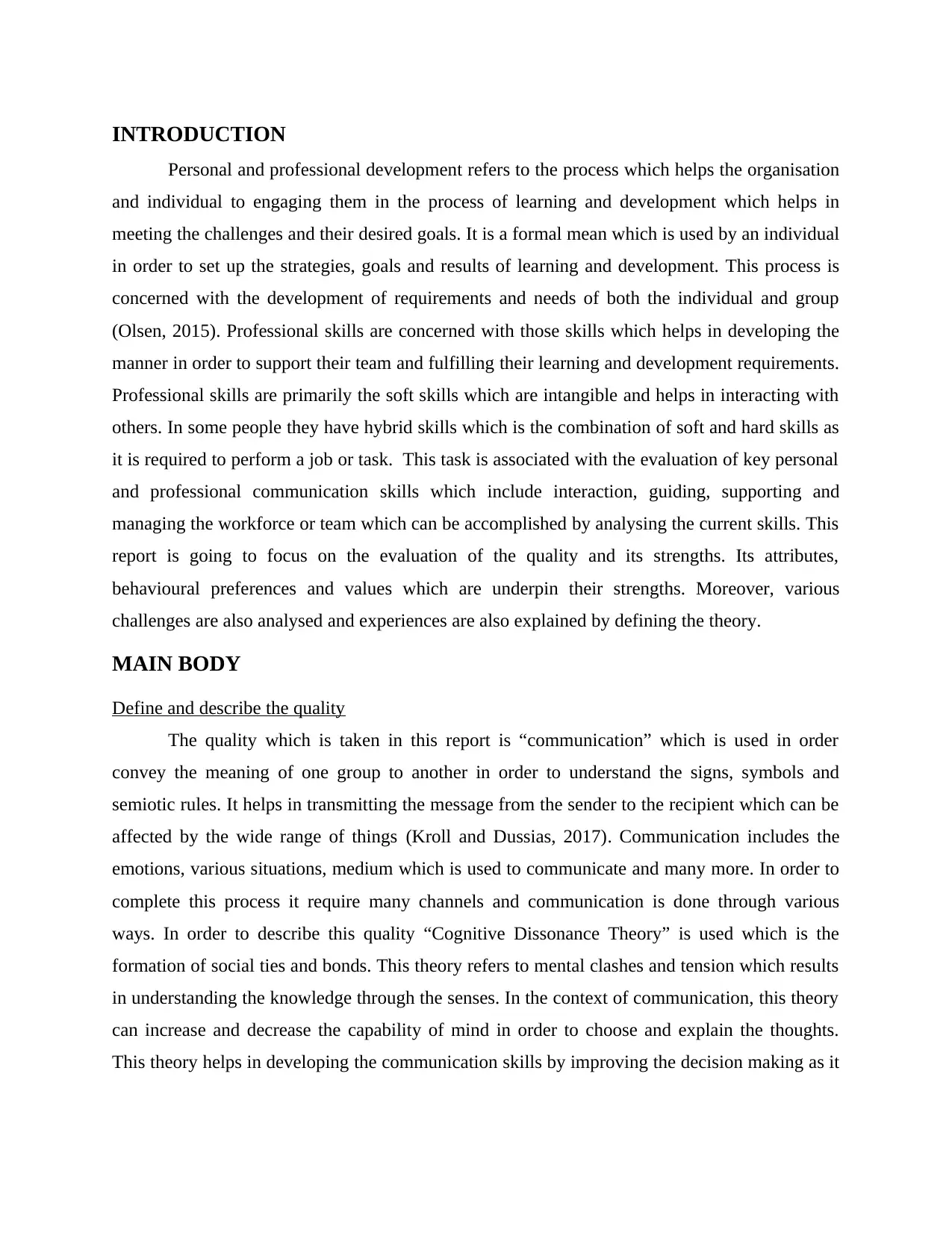
INTRODUCTION
Personal and professional development refers to the process which helps the organisation
and individual to engaging them in the process of learning and development which helps in
meeting the challenges and their desired goals. It is a formal mean which is used by an individual
in order to set up the strategies, goals and results of learning and development. This process is
concerned with the development of requirements and needs of both the individual and group
(Olsen, 2015). Professional skills are concerned with those skills which helps in developing the
manner in order to support their team and fulfilling their learning and development requirements.
Professional skills are primarily the soft skills which are intangible and helps in interacting with
others. In some people they have hybrid skills which is the combination of soft and hard skills as
it is required to perform a job or task. This task is associated with the evaluation of key personal
and professional communication skills which include interaction, guiding, supporting and
managing the workforce or team which can be accomplished by analysing the current skills. This
report is going to focus on the evaluation of the quality and its strengths. Its attributes,
behavioural preferences and values which are underpin their strengths. Moreover, various
challenges are also analysed and experiences are also explained by defining the theory.
MAIN BODY
Define and describe the quality
The quality which is taken in this report is “communication” which is used in order
convey the meaning of one group to another in order to understand the signs, symbols and
semiotic rules. It helps in transmitting the message from the sender to the recipient which can be
affected by the wide range of things (Kroll and Dussias, 2017). Communication includes the
emotions, various situations, medium which is used to communicate and many more. In order to
complete this process it require many channels and communication is done through various
ways. In order to describe this quality “Cognitive Dissonance Theory” is used which is the
formation of social ties and bonds. This theory refers to mental clashes and tension which results
in understanding the knowledge through the senses. In the context of communication, this theory
can increase and decrease the capability of mind in order to choose and explain the thoughts.
This theory helps in developing the communication skills by improving the decision making as it
Personal and professional development refers to the process which helps the organisation
and individual to engaging them in the process of learning and development which helps in
meeting the challenges and their desired goals. It is a formal mean which is used by an individual
in order to set up the strategies, goals and results of learning and development. This process is
concerned with the development of requirements and needs of both the individual and group
(Olsen, 2015). Professional skills are concerned with those skills which helps in developing the
manner in order to support their team and fulfilling their learning and development requirements.
Professional skills are primarily the soft skills which are intangible and helps in interacting with
others. In some people they have hybrid skills which is the combination of soft and hard skills as
it is required to perform a job or task. This task is associated with the evaluation of key personal
and professional communication skills which include interaction, guiding, supporting and
managing the workforce or team which can be accomplished by analysing the current skills. This
report is going to focus on the evaluation of the quality and its strengths. Its attributes,
behavioural preferences and values which are underpin their strengths. Moreover, various
challenges are also analysed and experiences are also explained by defining the theory.
MAIN BODY
Define and describe the quality
The quality which is taken in this report is “communication” which is used in order
convey the meaning of one group to another in order to understand the signs, symbols and
semiotic rules. It helps in transmitting the message from the sender to the recipient which can be
affected by the wide range of things (Kroll and Dussias, 2017). Communication includes the
emotions, various situations, medium which is used to communicate and many more. In order to
complete this process it require many channels and communication is done through various
ways. In order to describe this quality “Cognitive Dissonance Theory” is used which is the
formation of social ties and bonds. This theory refers to mental clashes and tension which results
in understanding the knowledge through the senses. In the context of communication, this theory
can increase and decrease the capability of mind in order to choose and explain the thoughts.
This theory helps in developing the communication skills by improving the decision making as it
Paraphrase This Document
Need a fresh take? Get an instant paraphrase of this document with our AI Paraphraser
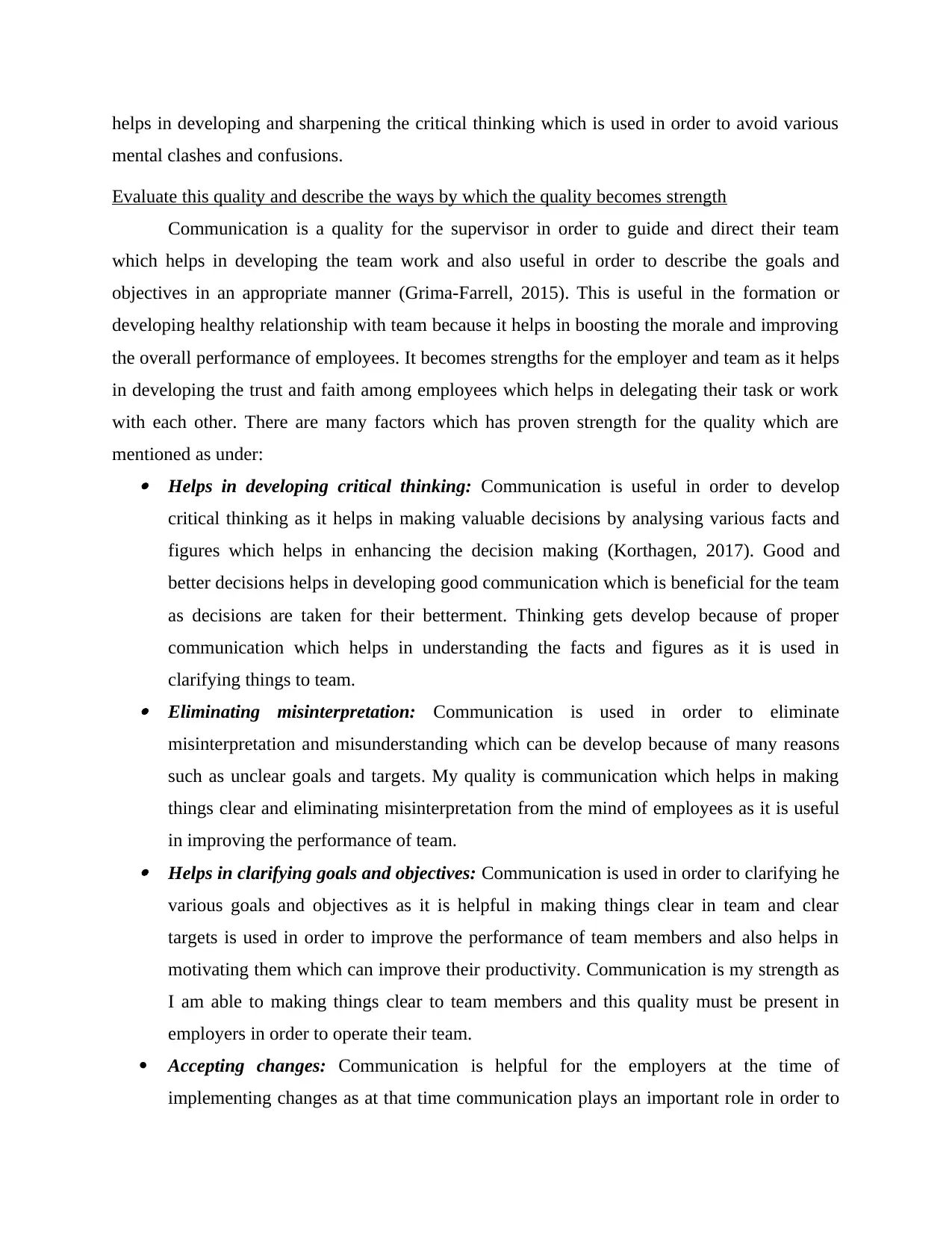
helps in developing and sharpening the critical thinking which is used in order to avoid various
mental clashes and confusions.
Evaluate this quality and describe the ways by which the quality becomes strength
Communication is a quality for the supervisor in order to guide and direct their team
which helps in developing the team work and also useful in order to describe the goals and
objectives in an appropriate manner (Grima-Farrell, 2015). This is useful in the formation or
developing healthy relationship with team because it helps in boosting the morale and improving
the overall performance of employees. It becomes strengths for the employer and team as it helps
in developing the trust and faith among employees which helps in delegating their task or work
with each other. There are many factors which has proven strength for the quality which are
mentioned as under: Helps in developing critical thinking: Communication is useful in order to develop
critical thinking as it helps in making valuable decisions by analysing various facts and
figures which helps in enhancing the decision making (Korthagen, 2017). Good and
better decisions helps in developing good communication which is beneficial for the team
as decisions are taken for their betterment. Thinking gets develop because of proper
communication which helps in understanding the facts and figures as it is used in
clarifying things to team. Eliminating misinterpretation: Communication is used in order to eliminate
misinterpretation and misunderstanding which can be develop because of many reasons
such as unclear goals and targets. My quality is communication which helps in making
things clear and eliminating misinterpretation from the mind of employees as it is useful
in improving the performance of team. Helps in clarifying goals and objectives: Communication is used in order to clarifying he
various goals and objectives as it is helpful in making things clear in team and clear
targets is used in order to improve the performance of team members and also helps in
motivating them which can improve their productivity. Communication is my strength as
I am able to making things clear to team members and this quality must be present in
employers in order to operate their team.
Accepting changes: Communication is helpful for the employers at the time of
implementing changes as at that time communication plays an important role in order to
mental clashes and confusions.
Evaluate this quality and describe the ways by which the quality becomes strength
Communication is a quality for the supervisor in order to guide and direct their team
which helps in developing the team work and also useful in order to describe the goals and
objectives in an appropriate manner (Grima-Farrell, 2015). This is useful in the formation or
developing healthy relationship with team because it helps in boosting the morale and improving
the overall performance of employees. It becomes strengths for the employer and team as it helps
in developing the trust and faith among employees which helps in delegating their task or work
with each other. There are many factors which has proven strength for the quality which are
mentioned as under: Helps in developing critical thinking: Communication is useful in order to develop
critical thinking as it helps in making valuable decisions by analysing various facts and
figures which helps in enhancing the decision making (Korthagen, 2017). Good and
better decisions helps in developing good communication which is beneficial for the team
as decisions are taken for their betterment. Thinking gets develop because of proper
communication which helps in understanding the facts and figures as it is used in
clarifying things to team. Eliminating misinterpretation: Communication is used in order to eliminate
misinterpretation and misunderstanding which can be develop because of many reasons
such as unclear goals and targets. My quality is communication which helps in making
things clear and eliminating misinterpretation from the mind of employees as it is useful
in improving the performance of team. Helps in clarifying goals and objectives: Communication is used in order to clarifying he
various goals and objectives as it is helpful in making things clear in team and clear
targets is used in order to improve the performance of team members and also helps in
motivating them which can improve their productivity. Communication is my strength as
I am able to making things clear to team members and this quality must be present in
employers in order to operate their team.
Accepting changes: Communication is helpful for the employers at the time of
implementing changes as at that time communication plays an important role in order to
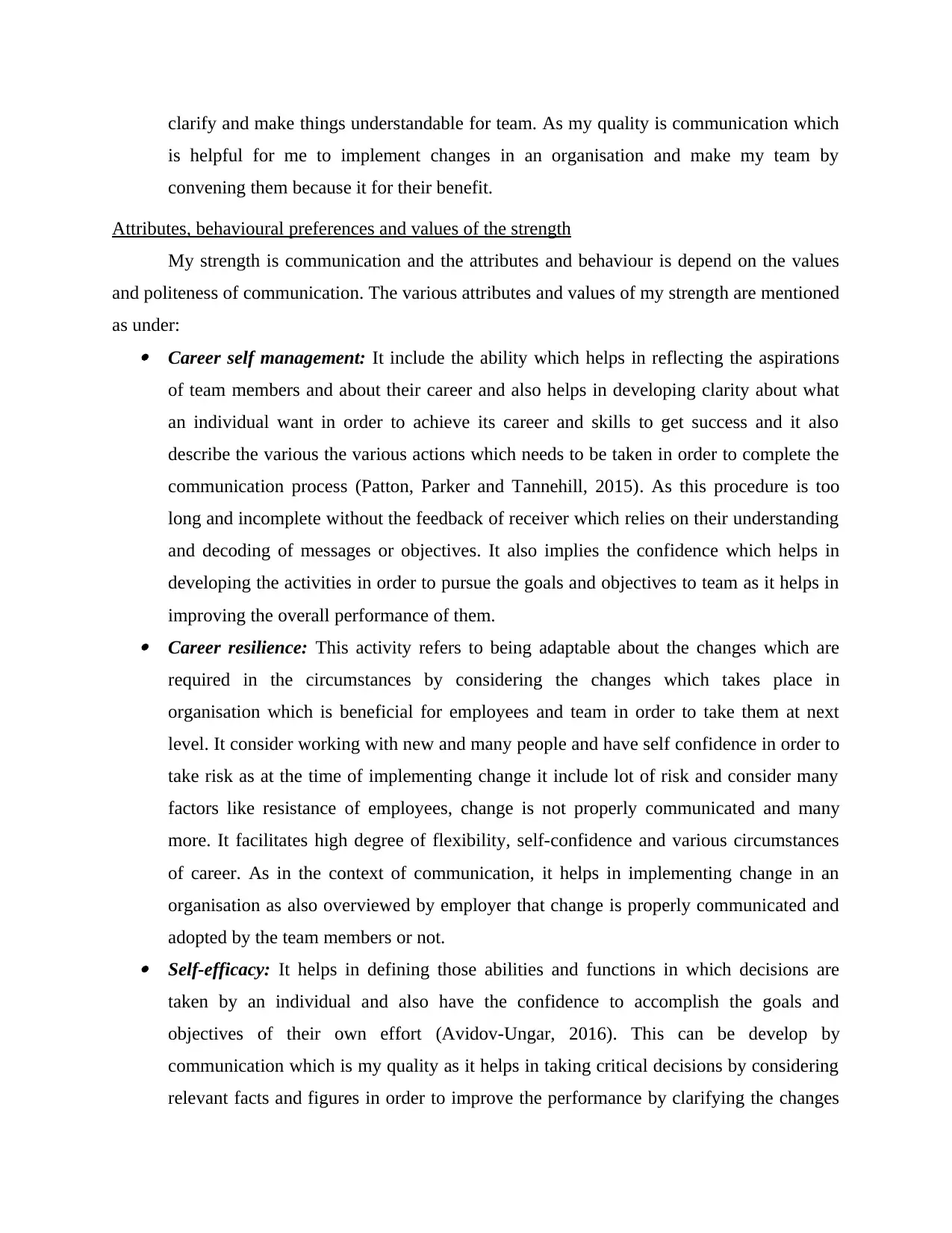
clarify and make things understandable for team. As my quality is communication which
is helpful for me to implement changes in an organisation and make my team by
convening them because it for their benefit.
Attributes, behavioural preferences and values of the strength
My strength is communication and the attributes and behaviour is depend on the values
and politeness of communication. The various attributes and values of my strength are mentioned
as under: Career self management: It include the ability which helps in reflecting the aspirations
of team members and about their career and also helps in developing clarity about what
an individual want in order to achieve its career and skills to get success and it also
describe the various the various actions which needs to be taken in order to complete the
communication process (Patton, Parker and Tannehill, 2015). As this procedure is too
long and incomplete without the feedback of receiver which relies on their understanding
and decoding of messages or objectives. It also implies the confidence which helps in
developing the activities in order to pursue the goals and objectives to team as it helps in
improving the overall performance of them. Career resilience: This activity refers to being adaptable about the changes which are
required in the circumstances by considering the changes which takes place in
organisation which is beneficial for employees and team in order to take them at next
level. It consider working with new and many people and have self confidence in order to
take risk as at the time of implementing change it include lot of risk and consider many
factors like resistance of employees, change is not properly communicated and many
more. It facilitates high degree of flexibility, self-confidence and various circumstances
of career. As in the context of communication, it helps in implementing change in an
organisation as also overviewed by employer that change is properly communicated and
adopted by the team members or not. Self-efficacy: It helps in defining those abilities and functions in which decisions are
taken by an individual and also have the confidence to accomplish the goals and
objectives of their own effort (Avidov-Ungar, 2016). This can be develop by
communication which is my quality as it helps in taking critical decisions by considering
relevant facts and figures in order to improve the performance by clarifying the changes
is helpful for me to implement changes in an organisation and make my team by
convening them because it for their benefit.
Attributes, behavioural preferences and values of the strength
My strength is communication and the attributes and behaviour is depend on the values
and politeness of communication. The various attributes and values of my strength are mentioned
as under: Career self management: It include the ability which helps in reflecting the aspirations
of team members and about their career and also helps in developing clarity about what
an individual want in order to achieve its career and skills to get success and it also
describe the various the various actions which needs to be taken in order to complete the
communication process (Patton, Parker and Tannehill, 2015). As this procedure is too
long and incomplete without the feedback of receiver which relies on their understanding
and decoding of messages or objectives. It also implies the confidence which helps in
developing the activities in order to pursue the goals and objectives to team as it helps in
improving the overall performance of them. Career resilience: This activity refers to being adaptable about the changes which are
required in the circumstances by considering the changes which takes place in
organisation which is beneficial for employees and team in order to take them at next
level. It consider working with new and many people and have self confidence in order to
take risk as at the time of implementing change it include lot of risk and consider many
factors like resistance of employees, change is not properly communicated and many
more. It facilitates high degree of flexibility, self-confidence and various circumstances
of career. As in the context of communication, it helps in implementing change in an
organisation as also overviewed by employer that change is properly communicated and
adopted by the team members or not. Self-efficacy: It helps in defining those abilities and functions in which decisions are
taken by an individual and also have the confidence to accomplish the goals and
objectives of their own effort (Avidov-Ungar, 2016). This can be develop by
communication which is my quality as it helps in taking critical decisions by considering
relevant facts and figures in order to improve the performance by clarifying the changes
⊘ This is a preview!⊘
Do you want full access?
Subscribe today to unlock all pages.

Trusted by 1+ million students worldwide
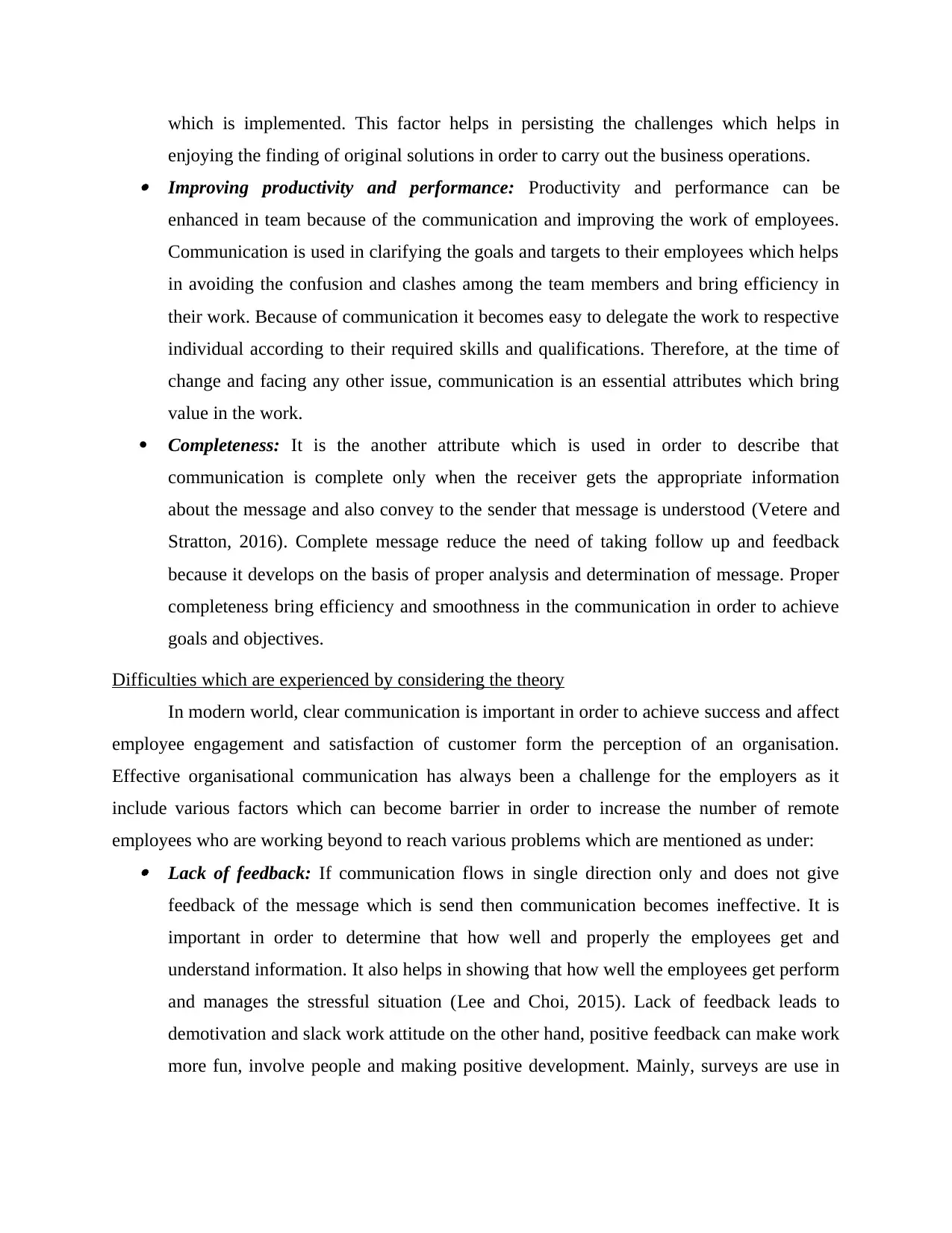
which is implemented. This factor helps in persisting the challenges which helps in
enjoying the finding of original solutions in order to carry out the business operations. Improving productivity and performance: Productivity and performance can be
enhanced in team because of the communication and improving the work of employees.
Communication is used in clarifying the goals and targets to their employees which helps
in avoiding the confusion and clashes among the team members and bring efficiency in
their work. Because of communication it becomes easy to delegate the work to respective
individual according to their required skills and qualifications. Therefore, at the time of
change and facing any other issue, communication is an essential attributes which bring
value in the work.
Completeness: It is the another attribute which is used in order to describe that
communication is complete only when the receiver gets the appropriate information
about the message and also convey to the sender that message is understood (Vetere and
Stratton, 2016). Complete message reduce the need of taking follow up and feedback
because it develops on the basis of proper analysis and determination of message. Proper
completeness bring efficiency and smoothness in the communication in order to achieve
goals and objectives.
Difficulties which are experienced by considering the theory
In modern world, clear communication is important in order to achieve success and affect
employee engagement and satisfaction of customer form the perception of an organisation.
Effective organisational communication has always been a challenge for the employers as it
include various factors which can become barrier in order to increase the number of remote
employees who are working beyond to reach various problems which are mentioned as under: Lack of feedback: If communication flows in single direction only and does not give
feedback of the message which is send then communication becomes ineffective. It is
important in order to determine that how well and properly the employees get and
understand information. It also helps in showing that how well the employees get perform
and manages the stressful situation (Lee and Choi, 2015). Lack of feedback leads to
demotivation and slack work attitude on the other hand, positive feedback can make work
more fun, involve people and making positive development. Mainly, surveys are use in
enjoying the finding of original solutions in order to carry out the business operations. Improving productivity and performance: Productivity and performance can be
enhanced in team because of the communication and improving the work of employees.
Communication is used in clarifying the goals and targets to their employees which helps
in avoiding the confusion and clashes among the team members and bring efficiency in
their work. Because of communication it becomes easy to delegate the work to respective
individual according to their required skills and qualifications. Therefore, at the time of
change and facing any other issue, communication is an essential attributes which bring
value in the work.
Completeness: It is the another attribute which is used in order to describe that
communication is complete only when the receiver gets the appropriate information
about the message and also convey to the sender that message is understood (Vetere and
Stratton, 2016). Complete message reduce the need of taking follow up and feedback
because it develops on the basis of proper analysis and determination of message. Proper
completeness bring efficiency and smoothness in the communication in order to achieve
goals and objectives.
Difficulties which are experienced by considering the theory
In modern world, clear communication is important in order to achieve success and affect
employee engagement and satisfaction of customer form the perception of an organisation.
Effective organisational communication has always been a challenge for the employers as it
include various factors which can become barrier in order to increase the number of remote
employees who are working beyond to reach various problems which are mentioned as under: Lack of feedback: If communication flows in single direction only and does not give
feedback of the message which is send then communication becomes ineffective. It is
important in order to determine that how well and properly the employees get and
understand information. It also helps in showing that how well the employees get perform
and manages the stressful situation (Lee and Choi, 2015). Lack of feedback leads to
demotivation and slack work attitude on the other hand, positive feedback can make work
more fun, involve people and making positive development. Mainly, surveys are use in
Paraphrase This Document
Need a fresh take? Get an instant paraphrase of this document with our AI Paraphraser
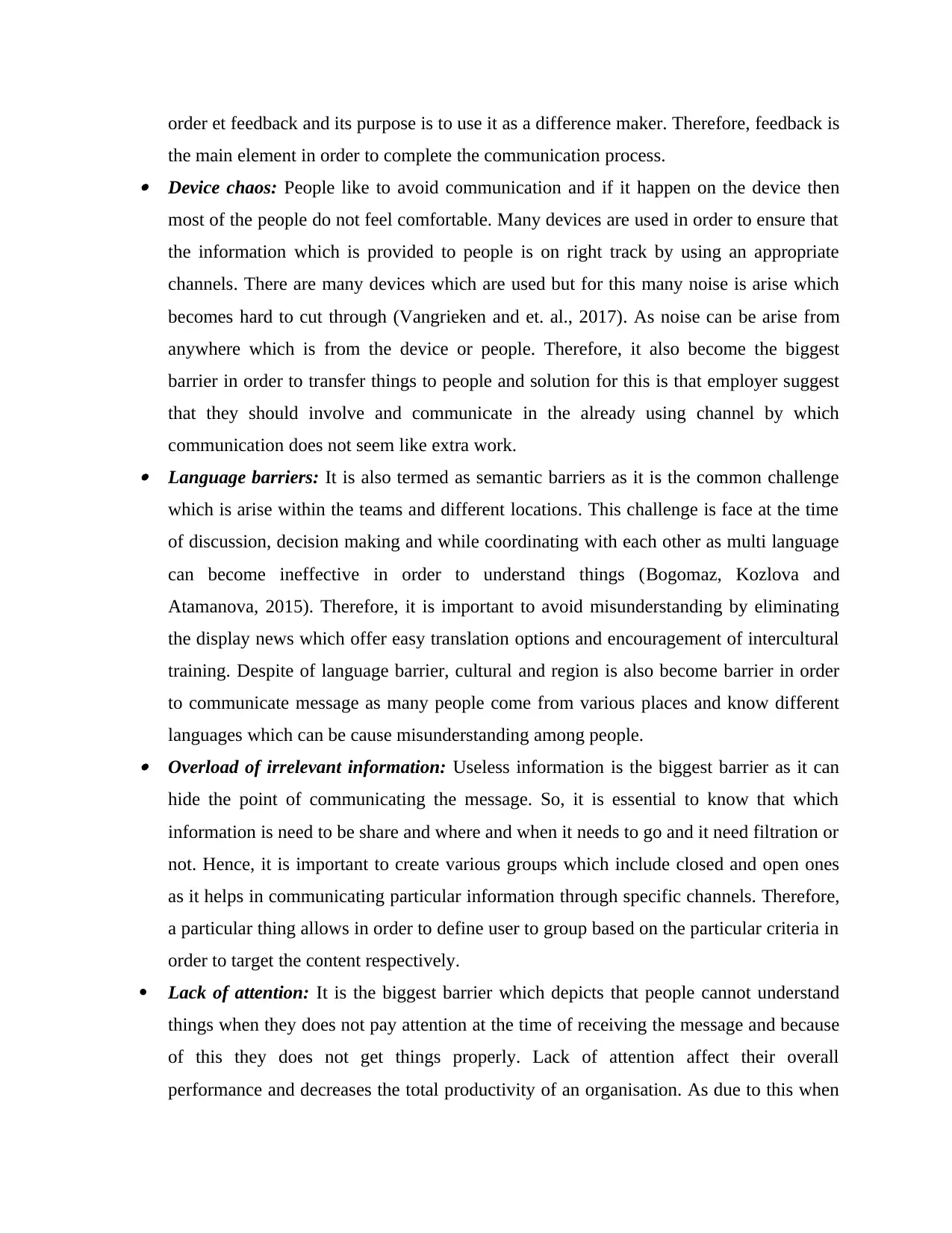
order et feedback and its purpose is to use it as a difference maker. Therefore, feedback is
the main element in order to complete the communication process. Device chaos: People like to avoid communication and if it happen on the device then
most of the people do not feel comfortable. Many devices are used in order to ensure that
the information which is provided to people is on right track by using an appropriate
channels. There are many devices which are used but for this many noise is arise which
becomes hard to cut through (Vangrieken and et. al., 2017). As noise can be arise from
anywhere which is from the device or people. Therefore, it also become the biggest
barrier in order to transfer things to people and solution for this is that employer suggest
that they should involve and communicate in the already using channel by which
communication does not seem like extra work. Language barriers: It is also termed as semantic barriers as it is the common challenge
which is arise within the teams and different locations. This challenge is face at the time
of discussion, decision making and while coordinating with each other as multi language
can become ineffective in order to understand things (Bogomaz, Kozlova and
Atamanova, 2015). Therefore, it is important to avoid misunderstanding by eliminating
the display news which offer easy translation options and encouragement of intercultural
training. Despite of language barrier, cultural and region is also become barrier in order
to communicate message as many people come from various places and know different
languages which can be cause misunderstanding among people. Overload of irrelevant information: Useless information is the biggest barrier as it can
hide the point of communicating the message. So, it is essential to know that which
information is need to be share and where and when it needs to go and it need filtration or
not. Hence, it is important to create various groups which include closed and open ones
as it helps in communicating particular information through specific channels. Therefore,
a particular thing allows in order to define user to group based on the particular criteria in
order to target the content respectively.
Lack of attention: It is the biggest barrier which depicts that people cannot understand
things when they does not pay attention at the time of receiving the message and because
of this they does not get things properly. Lack of attention affect their overall
performance and decreases the total productivity of an organisation. As due to this when
the main element in order to complete the communication process. Device chaos: People like to avoid communication and if it happen on the device then
most of the people do not feel comfortable. Many devices are used in order to ensure that
the information which is provided to people is on right track by using an appropriate
channels. There are many devices which are used but for this many noise is arise which
becomes hard to cut through (Vangrieken and et. al., 2017). As noise can be arise from
anywhere which is from the device or people. Therefore, it also become the biggest
barrier in order to transfer things to people and solution for this is that employer suggest
that they should involve and communicate in the already using channel by which
communication does not seem like extra work. Language barriers: It is also termed as semantic barriers as it is the common challenge
which is arise within the teams and different locations. This challenge is face at the time
of discussion, decision making and while coordinating with each other as multi language
can become ineffective in order to understand things (Bogomaz, Kozlova and
Atamanova, 2015). Therefore, it is important to avoid misunderstanding by eliminating
the display news which offer easy translation options and encouragement of intercultural
training. Despite of language barrier, cultural and region is also become barrier in order
to communicate message as many people come from various places and know different
languages which can be cause misunderstanding among people. Overload of irrelevant information: Useless information is the biggest barrier as it can
hide the point of communicating the message. So, it is essential to know that which
information is need to be share and where and when it needs to go and it need filtration or
not. Hence, it is important to create various groups which include closed and open ones
as it helps in communicating particular information through specific channels. Therefore,
a particular thing allows in order to define user to group based on the particular criteria in
order to target the content respectively.
Lack of attention: It is the biggest barrier which depicts that people cannot understand
things when they does not pay attention at the time of receiving the message and because
of this they does not get things properly. Lack of attention affect their overall
performance and decreases the total productivity of an organisation. As due to this when
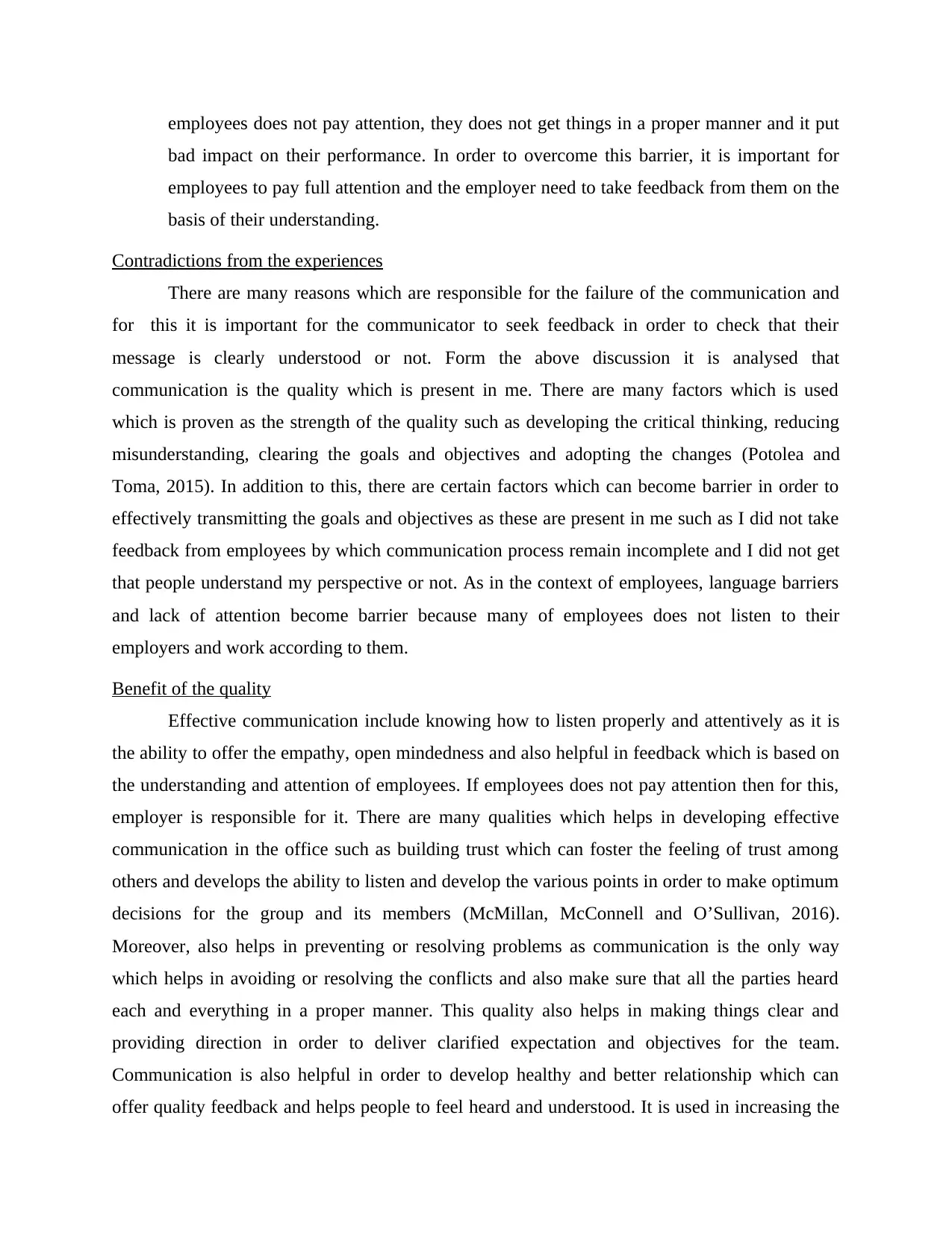
employees does not pay attention, they does not get things in a proper manner and it put
bad impact on their performance. In order to overcome this barrier, it is important for
employees to pay full attention and the employer need to take feedback from them on the
basis of their understanding.
Contradictions from the experiences
There are many reasons which are responsible for the failure of the communication and
for this it is important for the communicator to seek feedback in order to check that their
message is clearly understood or not. Form the above discussion it is analysed that
communication is the quality which is present in me. There are many factors which is used
which is proven as the strength of the quality such as developing the critical thinking, reducing
misunderstanding, clearing the goals and objectives and adopting the changes (Potolea and
Toma, 2015). In addition to this, there are certain factors which can become barrier in order to
effectively transmitting the goals and objectives as these are present in me such as I did not take
feedback from employees by which communication process remain incomplete and I did not get
that people understand my perspective or not. As in the context of employees, language barriers
and lack of attention become barrier because many of employees does not listen to their
employers and work according to them.
Benefit of the quality
Effective communication include knowing how to listen properly and attentively as it is
the ability to offer the empathy, open mindedness and also helpful in feedback which is based on
the understanding and attention of employees. If employees does not pay attention then for this,
employer is responsible for it. There are many qualities which helps in developing effective
communication in the office such as building trust which can foster the feeling of trust among
others and develops the ability to listen and develop the various points in order to make optimum
decisions for the group and its members (McMillan, McConnell and O’Sullivan, 2016).
Moreover, also helps in preventing or resolving problems as communication is the only way
which helps in avoiding or resolving the conflicts and also make sure that all the parties heard
each and everything in a proper manner. This quality also helps in making things clear and
providing direction in order to deliver clarified expectation and objectives for the team.
Communication is also helpful in order to develop healthy and better relationship which can
offer quality feedback and helps people to feel heard and understood. It is used in increasing the
bad impact on their performance. In order to overcome this barrier, it is important for
employees to pay full attention and the employer need to take feedback from them on the
basis of their understanding.
Contradictions from the experiences
There are many reasons which are responsible for the failure of the communication and
for this it is important for the communicator to seek feedback in order to check that their
message is clearly understood or not. Form the above discussion it is analysed that
communication is the quality which is present in me. There are many factors which is used
which is proven as the strength of the quality such as developing the critical thinking, reducing
misunderstanding, clearing the goals and objectives and adopting the changes (Potolea and
Toma, 2015). In addition to this, there are certain factors which can become barrier in order to
effectively transmitting the goals and objectives as these are present in me such as I did not take
feedback from employees by which communication process remain incomplete and I did not get
that people understand my perspective or not. As in the context of employees, language barriers
and lack of attention become barrier because many of employees does not listen to their
employers and work according to them.
Benefit of the quality
Effective communication include knowing how to listen properly and attentively as it is
the ability to offer the empathy, open mindedness and also helpful in feedback which is based on
the understanding and attention of employees. If employees does not pay attention then for this,
employer is responsible for it. There are many qualities which helps in developing effective
communication in the office such as building trust which can foster the feeling of trust among
others and develops the ability to listen and develop the various points in order to make optimum
decisions for the group and its members (McMillan, McConnell and O’Sullivan, 2016).
Moreover, also helps in preventing or resolving problems as communication is the only way
which helps in avoiding or resolving the conflicts and also make sure that all the parties heard
each and everything in a proper manner. This quality also helps in making things clear and
providing direction in order to deliver clarified expectation and objectives for the team.
Communication is also helpful in order to develop healthy and better relationship which can
offer quality feedback and helps people to feel heard and understood. It is used in increasing the
⊘ This is a preview!⊘
Do you want full access?
Subscribe today to unlock all pages.

Trusted by 1+ million students worldwide
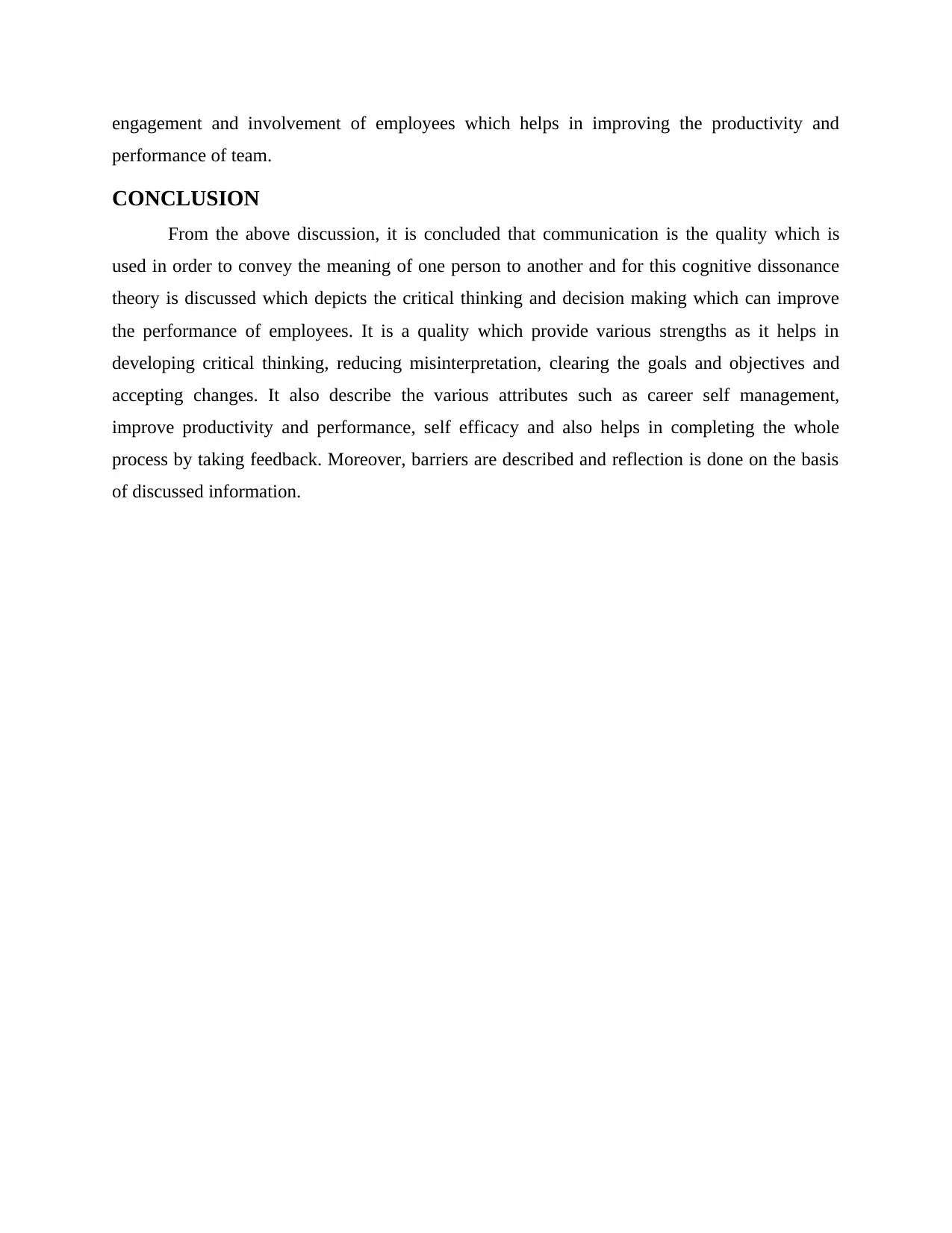
engagement and involvement of employees which helps in improving the productivity and
performance of team.
CONCLUSION
From the above discussion, it is concluded that communication is the quality which is
used in order to convey the meaning of one person to another and for this cognitive dissonance
theory is discussed which depicts the critical thinking and decision making which can improve
the performance of employees. It is a quality which provide various strengths as it helps in
developing critical thinking, reducing misinterpretation, clearing the goals and objectives and
accepting changes. It also describe the various attributes such as career self management,
improve productivity and performance, self efficacy and also helps in completing the whole
process by taking feedback. Moreover, barriers are described and reflection is done on the basis
of discussed information.
performance of team.
CONCLUSION
From the above discussion, it is concluded that communication is the quality which is
used in order to convey the meaning of one person to another and for this cognitive dissonance
theory is discussed which depicts the critical thinking and decision making which can improve
the performance of employees. It is a quality which provide various strengths as it helps in
developing critical thinking, reducing misinterpretation, clearing the goals and objectives and
accepting changes. It also describe the various attributes such as career self management,
improve productivity and performance, self efficacy and also helps in completing the whole
process by taking feedback. Moreover, barriers are described and reflection is done on the basis
of discussed information.
Paraphrase This Document
Need a fresh take? Get an instant paraphrase of this document with our AI Paraphraser
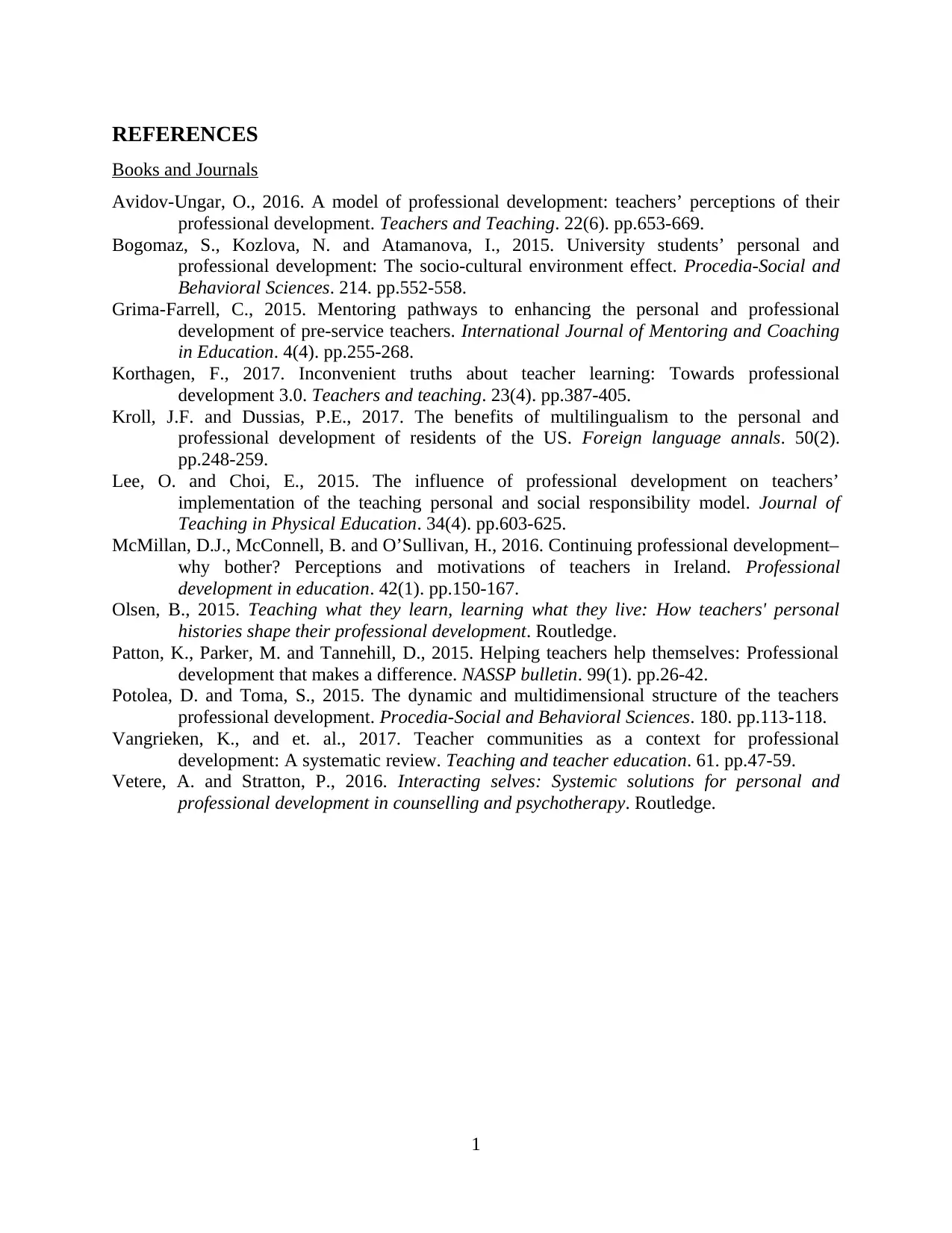
REFERENCES
Books and Journals
Avidov-Ungar, O., 2016. A model of professional development: teachers’ perceptions of their
professional development. Teachers and Teaching. 22(6). pp.653-669.
Bogomaz, S., Kozlova, N. and Atamanova, I., 2015. University students’ personal and
professional development: The socio-cultural environment effect. Procedia-Social and
Behavioral Sciences. 214. pp.552-558.
Grima-Farrell, C., 2015. Mentoring pathways to enhancing the personal and professional
development of pre-service teachers. International Journal of Mentoring and Coaching
in Education. 4(4). pp.255-268.
Korthagen, F., 2017. Inconvenient truths about teacher learning: Towards professional
development 3.0. Teachers and teaching. 23(4). pp.387-405.
Kroll, J.F. and Dussias, P.E., 2017. The benefits of multilingualism to the personal and
professional development of residents of the US. Foreign language annals. 50(2).
pp.248-259.
Lee, O. and Choi, E., 2015. The influence of professional development on teachers’
implementation of the teaching personal and social responsibility model. Journal of
Teaching in Physical Education. 34(4). pp.603-625.
McMillan, D.J., McConnell, B. and O’Sullivan, H., 2016. Continuing professional development–
why bother? Perceptions and motivations of teachers in Ireland. Professional
development in education. 42(1). pp.150-167.
Olsen, B., 2015. Teaching what they learn, learning what they live: How teachers' personal
histories shape their professional development. Routledge.
Patton, K., Parker, M. and Tannehill, D., 2015. Helping teachers help themselves: Professional
development that makes a difference. NASSP bulletin. 99(1). pp.26-42.
Potolea, D. and Toma, S., 2015. The dynamic and multidimensional structure of the teachers
professional development. Procedia-Social and Behavioral Sciences. 180. pp.113-118.
Vangrieken, K., and et. al., 2017. Teacher communities as a context for professional
development: A systematic review. Teaching and teacher education. 61. pp.47-59.
Vetere, A. and Stratton, P., 2016. Interacting selves: Systemic solutions for personal and
professional development in counselling and psychotherapy. Routledge.
1
Books and Journals
Avidov-Ungar, O., 2016. A model of professional development: teachers’ perceptions of their
professional development. Teachers and Teaching. 22(6). pp.653-669.
Bogomaz, S., Kozlova, N. and Atamanova, I., 2015. University students’ personal and
professional development: The socio-cultural environment effect. Procedia-Social and
Behavioral Sciences. 214. pp.552-558.
Grima-Farrell, C., 2015. Mentoring pathways to enhancing the personal and professional
development of pre-service teachers. International Journal of Mentoring and Coaching
in Education. 4(4). pp.255-268.
Korthagen, F., 2017. Inconvenient truths about teacher learning: Towards professional
development 3.0. Teachers and teaching. 23(4). pp.387-405.
Kroll, J.F. and Dussias, P.E., 2017. The benefits of multilingualism to the personal and
professional development of residents of the US. Foreign language annals. 50(2).
pp.248-259.
Lee, O. and Choi, E., 2015. The influence of professional development on teachers’
implementation of the teaching personal and social responsibility model. Journal of
Teaching in Physical Education. 34(4). pp.603-625.
McMillan, D.J., McConnell, B. and O’Sullivan, H., 2016. Continuing professional development–
why bother? Perceptions and motivations of teachers in Ireland. Professional
development in education. 42(1). pp.150-167.
Olsen, B., 2015. Teaching what they learn, learning what they live: How teachers' personal
histories shape their professional development. Routledge.
Patton, K., Parker, M. and Tannehill, D., 2015. Helping teachers help themselves: Professional
development that makes a difference. NASSP bulletin. 99(1). pp.26-42.
Potolea, D. and Toma, S., 2015. The dynamic and multidimensional structure of the teachers
professional development. Procedia-Social and Behavioral Sciences. 180. pp.113-118.
Vangrieken, K., and et. al., 2017. Teacher communities as a context for professional
development: A systematic review. Teaching and teacher education. 61. pp.47-59.
Vetere, A. and Stratton, P., 2016. Interacting selves: Systemic solutions for personal and
professional development in counselling and psychotherapy. Routledge.
1
1 out of 11
Related Documents
Your All-in-One AI-Powered Toolkit for Academic Success.
+13062052269
info@desklib.com
Available 24*7 on WhatsApp / Email
![[object Object]](/_next/static/media/star-bottom.7253800d.svg)
Unlock your academic potential
Copyright © 2020–2025 A2Z Services. All Rights Reserved. Developed and managed by ZUCOL.





